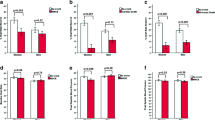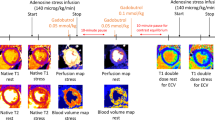Abstract
Background
In light of growing cardiovascular mortality rates observed in young women, sexual dimorphism in cardiac autonomic nervous control is gaining increasing attention. Heart rate responses to adenosine mirror autonomic activity and may carry important prognostic information.
Methods and Results
Hemodynamic changes during adenosine stress were retrospectively analysed in a propensity-matched cohort of 1932 consecutive patients undergoing myocardial perfusion single-photon-emission computed tomography (MPI-SPECT). Heart rate (HR) and systolic blood pressure (SBP) increased during adenosine infusion (P < 0.001). The increase in SBP and HR (heart rate reserve, HRR), was significantly more pronounced in women compared with men (P < 0.05). Patients ≤ 55 years had a higher HRR compared with patients > 55 years (46.8% vs 37.5%, P = 0.015). Women ≤ 55 years with a reversible perfusion defect on MPI-SPECT exhibited the highest HRR (89.2%), while age-matched men showed a blunted HR response to adenosine (26.4%, P = 0.01). Accordingly, age and an interaction term of female sex and increased HRR were identified as significant predictors of myocardial ischemia in a multiple regression analysis (OR 1.4, 95% CI 1.02-1.9, P = 0.038).
Conclusion
HRR during adenosine infusion is influenced by age and sex. Our data suggest a stronger, sympathetic-driven, hemodynamic response to adenosine in younger women with myocardial ischemia.


Similar content being viewed by others
Abbreviations
- BMI:
-
Body mass index
- CAD:
-
Coronary artery disease
- CACS:
-
Coronary artery calcium scoring
- CFR:
-
Coronary flow reserve
- CT:
-
Computed tomography
- HRR:
-
Heart rate reserve
- LVEF:
-
Left ventricular ejection fraction
- MAP:
-
Mean arterial pressure
- MCD:
-
Microvascular coronary dysfunction
- MPI-SPECT:
-
Myocardial perfusion single-photon-emission computed tomography
References
Heron M, Hoyert DL, Murphy SL, Xu J, Kochanek KD, et al. Deaths: final data for 2006. Natl Vital Stat Rep. 2009;57:1–134.
Wilmot KA, O’Flaherty M, Capewell S, Ford ES, Vaccarino V. Coronary heart disease mortality declines in the United States from 1979 through 2011: Evidence for stagnation in young adults, especially women. Circulation. 2015;132:997–1002.
Izadnegahdar M, Singer J, Lee MK, Gao M, Thompson CR, et al. Do younger women fare worse? Sex differences in acute myocardial infarction hospitalization and early mortality rates over ten years. J Womens Health (Larchmt). 2014;23:10–7.
Gabet A, Danchin N, Juilliere Y, Olie V. Acute coronary syndrome in women: rising hospitalizations in middle-aged French women, 2004–14. Eur Heart J. 2017;38:1060–5.
Reis SE, Holubkov R, Conrad Smith AJ, Kelsey SF, Sharaf BL, et al. Coronary microvascular dysfunction is highly prevalent in women with chest pain in the absence of coronary artery disease: Results from the NHLBI WISE study. Am Heart J. 2001;141:735–41.
Sharaf BL, Pepine CJ, Kerensky RA, Reis SE, Reichek N, et al. Detailed angiographic analysis of women with suspected ischemic chest pain (pilot phase data from the NHLBI-sponsored Women’s Ischemia Syndrome Evaluation [WISE] Study Angiographic Core Laboratory). Am J Cardiol. 2001;87:937–941; A3.
Lanza GA, Giordano A, Pristipino C, Calcagni ML, Meduri G, et al. Abnormal cardiac adrenergic nerve function in patients with syndrome X detected by [123I]metaiodobenzylguanidine myocardial scintigraphy. Circulation. 1997;96:821–6.
Adamopoulos S, Rosano GM, Ponikowski P, Cerquetani E, Piepoli M, et al. Impaired baroreflex sensitivity and sympathovagal balance in syndrome X. Am J Cardiol. 1998;82:862–8.
Madaric J, Bartunek J, Verhamme K, Penicka M, Van Schuerbeeck E, et al. Hyperdynamic myocardial response to beta-adrenergic stimulation in patients with chest pain and normal coronary arteries. J Am Coll Cardiol. 2005;46:1270–5.
Fredholm BB, Hedqvist P, Vernet L. Release of adenosine from the rabbit heart by sympathetic nerve stimulation. Acta Physiol Scand. 1979;106:381–2.
Hedqvist P, Fredholm BB. Inhibitory effect of adenosine on adrenergic neuroeffector transmission in the rabbit heart. Acta Physiol Scand. 1979;105:120–2.
Bravo PE, Hage FG, Woodham RM, Heo J, Iskandrian AE. Heart rate response to adenosine in patients with diabetes mellitus and normal myocardial perfusion imaging. Am J Cardiol. 2008;102:1103–6.
Conradson TB, Clarke B, Dixon CM, Dalton RN, Barnes PJ. Effects of adenosine on autonomic control of heart rate in man. Acta Physiol Scand. 1987;131:525–31.
Hage FG, Heo J, Franks B, Belardinelli L, Blackburn B, et al. Differences in heart rate response to adenosine and regadenoson in patients with and without diabetes mellitus. Am Heart J. 2009;157:771–6.
Hage FG, Perry G, Heo J, Iskandrian AE. Blunting of the heart rate response to adenosine and regadenoson in relation to hyperglycemia and the metabolic syndrome. Am J Cardiol. 2010;105:839–43.
Dorbala S, Di Carli MF, Delbeke D, Abbara S, DePuey EG, et al. SNMMI/ASNC/SCCT guideline for cardiac SPECT/CT and PET/CT 1.0. J Nucl Med. 2013;54:1485–507.
Reyes E, Stirrup J, Roughton M, D’Souza S, Underwood SR, et al. Attenuation of adenosine-induced myocardial perfusion heterogeneity by atenolol and other cardioselective beta-adrenoceptor blockers: a crossover myocardial perfusion imaging study. J Nucl Med. 2010;51:1036–43.
Verberne HJ, Acampa W, Anagnostopoulos C, Ballinger J, Bengel F, et al. EANM procedural guidelines for radionuclide myocardial perfusion imaging with SPECT and SPECT/CT: 2015 revision. Eur J Nucl Med Mol Imaging. 2015;42:1929–40.
Vashist A, Heller EN, Blum S, Brown EJ, Bhalodkar NC. Association of heart rate response with scan and left ventricular function on adenosine myocardial perfusion imaging. Am J Cardiol. 2002;89:174–7.
Amanullah AM, Berman DS, Hachamovitch R, Kiat H, Kang X, et al. Identification of severe or extensive coronary artery disease in women by adenosine technetium-99 m sestamibi SPECT. Am J Cardiol. 1997;80:132–7.
Abidov A, Hachamovitch R, Hayes SW, Ng CK, Cohen I, et al. Prognostic impact of hemodynamic response to adenosine in patients older than age 55 years undergoing vasodilator stress myocardial perfusion study. Circulation. 2003;107:2894–9.
Hage FG, Dean P, Iqbal F, Heo J, Iskandrian AE. A blunted heart rate response to regadenoson is an independent prognostic indicator in patients undergoing myocardial perfusion imaging. J Nucl Cardiol. 2011;18:1086–94.
Amanullah AM, Berman DS, Erel J, Kiat H, Cohen I, et al. Incremental prognostic value of adenosine myocardial perfusion single-photon emission computed tomography in women with suspected coronary artery disease. Am J Cardiol. 1998;82:725–30.
Palatini P, Julius S. The role of cardiac autonomic function in hypertension and cardiovascular disease. Curr Hypertens Rep. 2009;11:199–205.
Johnston DL, Daley JR, Hodge DO, Hopfenspirger MR, Gibbons RJ. Hemodynamic responses and adverse effects associated with adenosine and dipyridamole pharmacologic stress testing: a comparison in 2,000 patients. Mayo Clin Proc. 1995;70:331–6.
Ogilby JD, Iskandrian AS, Untereker WJ, Heo J, Nguyen TN, et al. Effect of intravenous adenosine infusion on myocardial perfusion and function. Hemodynamic/angiographic and scintigraphic study. Circulation. 1992;86:887–95.
Aksut SV, Pancholy S, Cassel D, Cave V, Heo J, et al. Results of adenosine single photon emission computed tomography thallium-201 imaging in hemodynamic nonresponders. Am Heart J. 1995;130:67–70.
Vaccarino V, Wilmot K, Al Mheid I, Ramadan R, Pimple P, et al. Sex differences in mental stress-induced myocardial ischemia in patients with coronary heart disease. J Am Heart Assoc. 2016. https://doi.org/10.1161/JAHA.116.003630.
La Rovere MT, Bigger JT Jr, Marcus FI, Mortara A, Schwartz PJ. Baroreflex sensitivity and heart-rate variability in prediction of total cardiac mortality after myocardial infarction. ATRAMI (Autonomic Tone and Reflexes After Myocardial Infarction) Investigators. Lancet. 1998;351:478–84.
Nabel EG. Heart disease prevention in young women: Sounding an alarm. Circulation. 2015;132:989–91.
Gupta A, Wang Y, Spertus JA, Geda M, Lorenze N, et al. Trends in acute myocardial infarction in young patients and differences by sex and race, 2001 to 2010. J Am Coll Cardiol. 2014;64:337–45.
Lehto HR, Lehto S, Havulinna AS, Ketonen M, Lehtonen A, et al. Sex differences in short- and long-term case-fatality of myocardial infarction. Eur J Epidemiol. 2011;26:851–61.
Vaccarino V, Badimon L, Corti R, de Wit C, Dorobantu M, et al. Presentation, management, and outcomes of ischaemic heart disease in women. Nat Rev Cardiol. 2013;10:508–18.
Hachamovitch R, Berman DS, Shaw LJ, Kiat H, Cohen I, et al. Incremental prognostic value of myocardial perfusion single photon emission computed tomography for the prediction of cardiac death: differential stratification for risk of cardiac death and myocardial infarction. Circulation. 1998;97:535–43.
Disclosures
All authors have the following to disclose: The University Hospital of Zurich holds a research contract with GE Healthcare.
Author information
Authors and Affiliations
Corresponding author
Additional information
The authors of this article have provided a PowerPoint file, available for download at SpringerLink, which summarises the contents of the paper and is free for re-use at meetings and presentations. Search for the article DOI on SpringerLink.com.
Funding This work was supported by Grants from the Swiss National Science Foundation (SNSF), the Olga Mayenfisch Foundation, Switzerland, the OPO Foundation, Switzerland, the Novartis Foundation, Switzerland, and the Swissheart Foundation.
Electronic Supplementary Material
Below is the link to the electronic supplementary material.
Rights and permissions
About this article
Cite this article
Gebhard, C., Messerli, M., Lohmann, C. et al. Sex and age differences in the association of heart rate responses to adenosine and myocardial ischemia in patients undergoing myocardial perfusion imaging. J. Nucl. Cardiol. 27, 159–170 (2020). https://doi.org/10.1007/s12350-018-1276-x
Received:
Published:
Issue Date:
DOI: https://doi.org/10.1007/s12350-018-1276-x




